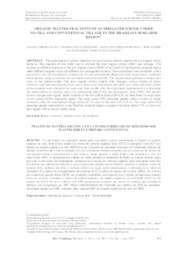Organic matter fractions of an irrigated oxisol under no-till and conventional tillage in the brazilian semi-arid region.
Organic matter fractions of an irrigated oxisol under no-till and conventional tillage in the brazilian semi-arid region.
Autoria: SALES, R. P.; PEGORARO, R. F.; PORTUGAL, A. F.; MOREIRA, J. A. A.; KONDO, M. K.
Resumo: ABSTRACT - The replacement of natural vegetation by crop systems directly impacts the soil organic matter fractions. The objective of this study was to evaluate the total organic carbon (TOC) and nitrogen (TN) contents in different fractions of the soil organic matter (SOM) of an Oxisol of the Brazilian semiarid region under different irrigated crops and different soil management systems. Seven treatments were evaluated, which consisted of two soil management systems (no-till and conventional tillage) and three crops (maize, sunflower and sorghum), using as reference the soil under a native forest (NF). The summer crops preceded common bean crops in the autumn-winter. The total organic carbon content, total nitrogen, carbon content in humic substances and their constituents (fulvic acids, humic acids and humin) and labile, non-labile and water-soluble carbon contents were evaluated two years and three months after the experiment implementation to determine the carbon lability (L) lability index (LI), partitioning index (CPI) and management index (CMI). The greatest carbon, nitrogen and organic matter contents in the soil surface layer (0.00-0.05 m) were found in crops under no-till system (NTS), especially maize. The crops under NTS presented greater carbon content in humic substances than the conventional tillage system (CTS) ones in the layer 0.05-0.10 m. The crops under NTS presented greater sustainability in the Brazilian semiarid region compared with those under CTS, as shown by their higher CMI in the soil surface layer. RESUMO - A substituição da vegetação natural pela agricultura impacta diretamente as frações da matéria orgânica no solo. Este estudo avaliou os teores de carbono orgânico total (COT) e nitrogênio total (NT) nas frações da matéria orgânica do solo (MOS) em um Latossolo do semiárido brasileiro sob diferentes sistemas de manejo com diferentes culturas irrigadas. Os sete tratamentos foram compostos por dois sistemas de manejo do solo (plantio direto e convencional) e três culturas: sorgo, girassol e milho tendo como referência o solo sob mata nativa (MN). A semeadura das culturas no verão precedeu a semeadura de feijão no outono/inverno. Após dois anos e três meses de implantação, avaliaram-se os teores de carbono orgânico total, nitrogênio total, teor de carbono nas substâncias húmicas e seus constituintes (fração ácidos fúlvicos, húmicos e humina), teores de carbono lábil, carbono não-lábil e carbono solúvel em água, sendo determinados a labilidade (L), índice de labilidade (IL), índice de compartimento de carbono (ICC) e índice de manejo de carbono (IMC). Os cultivos sob sistema de plantio direto (SPD) nas condições semiáridas, em especial com o milho, promoveram maiores teores de carbono, nitrogênio e frações da matéria orgânica, na camada superficial do solo (0,00 a 0,05 m). Na camada de 0,05-0,10 m os cultivos sob SPD promoveram aumento nos teores de carbono nas substâncias húmicas, em comparação aos SPC. Maior sustentabilidade foi observada nos cultivos em SPD no semiárido, em relação àqueles sob SPC, indicado pelos maiores IMC na camada superficial do solo sob SPD.
Ano de publicação: 2017
Tipo de publicação: Artigo de periódico
Unidade: Embrapa Milho e Sorgo
Palavras-chave: Carbono lábil, Matéria orgânica, Plantio convencional, Plantio direto, Substância húmica, Sustentabilidade
Observações
1 - Por padrão são exibidas publicações dos últimos 20 anos. Para encontrar publicações mais antigas, configure o filtro ano de publicação, colocando o ano a partir do qual você deseja encontrar publicações. O filtro está na coluna da esquerda na busca acima.
2 - Para ler algumas publicações da Embrapa (apenas as que estão em formato ePub), é necessário ter, no celular ou computador, um desses softwares gratuitos. Sistemas Android: Google Play Livros; IOS: iBooks; Windows e Linux: software Calibre.
Acesse outras publicações
Acesse a Base de Dados da Pesquisa Agropecuária (BDPA) para consultar o acervo completo das bibliotecas da Embrapa.

